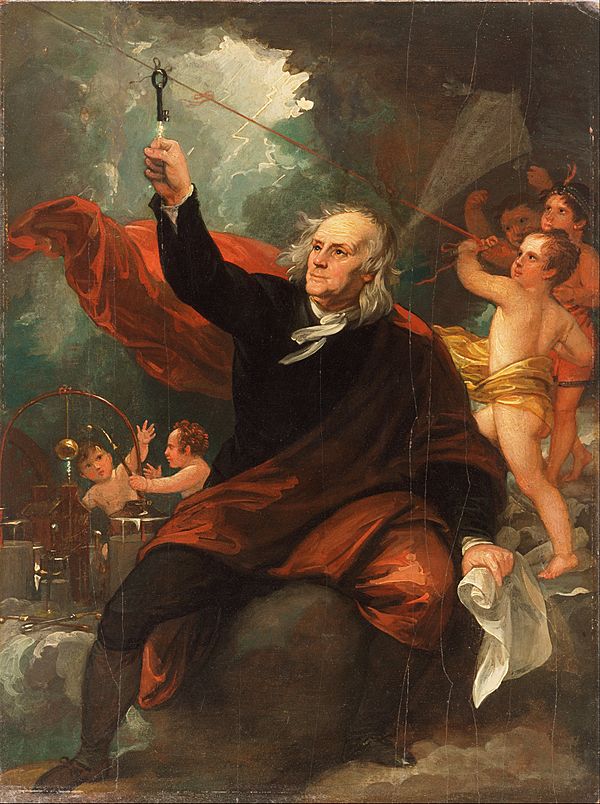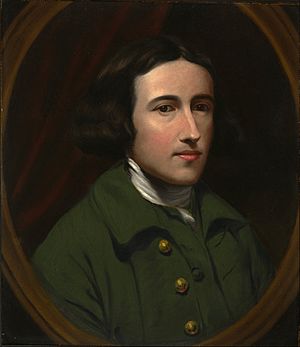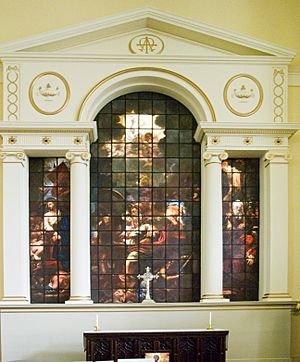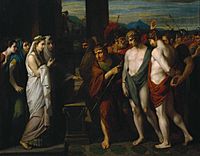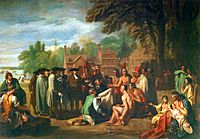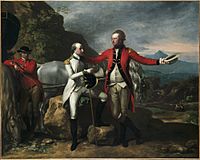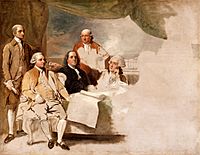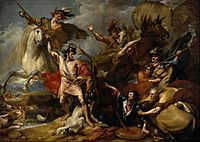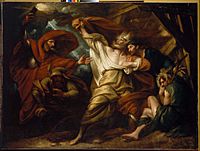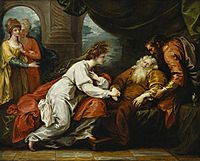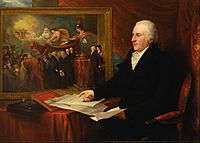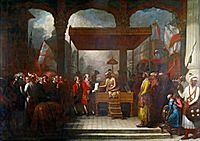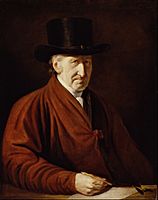Benjamin West facts for kids
Quick facts for kids
Benjamin West
PRA
|
|
|---|---|
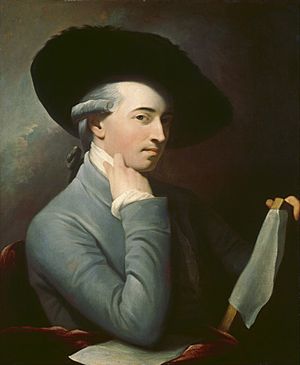
Self-portrait of Benjamin West, c. 1763
|
|
| Born | October 10, 1738 |
| Died | March 11, 1820 (aged 81) London, United Kingdom
|
| Known for | Historical painting |
| Patron(s) | William Henry King George III |
Benjamin West (born October 10, 1738 – died March 11, 1820) was a very famous American-born artist. He painted many important historical scenes. Some of his most well-known paintings include The Death of Nelson, The Death of General Wolfe, and Benjamin Franklin Drawing Electricity from the Sky.
Benjamin West taught himself how to paint. He soon found people who supported his art. He traveled around Europe and eventually settled in London, England. He made a great impression on King George III. West also played a big part in starting the Royal Academy. He became its second president. The King even made him the official historical painter for the royal court.
West also created large religious paintings. One huge work is The Preservation of St Paul after a Shipwreck at Malta. It is located in the Chapel of St Peter and St Paul in Greenwich. Another famous religious painting is Christ Healing the Sick, which is now in the National Gallery.
Contents
Early Life of Benjamin West
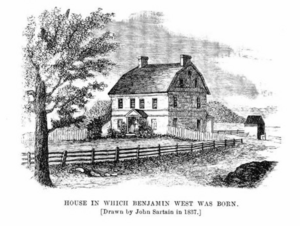
Benjamin West was born in Springfield, Pennsylvania. This house is now in the town of Swarthmore, Pennsylvania. He was the tenth child of an innkeeper and his wife. His family later moved to Newtown Square, Pennsylvania. His father ran a tavern there.
West once shared a story about his childhood. He said that Native Americans taught him how to make paint. They mixed clay from the river with bear grease. West learned to paint all by himself. Even though he became a great artist, he had little formal education. He even struggled with spelling later in life.
One day, when he was a child, Benjamin was left alone with his baby sister, Sally. He found some ink bottles and started to paint Sally's picture. When his mother came home, she saw the painting. She picked it up and said, "Why, it's Sally!" Then she kissed him. West later said, "My mother's kiss made me a painter."
From 1746 to 1759, West worked in Pennsylvania. He mostly painted portraits of people. In 1756, he was in Lancaster. His supporter, a gunsmith named William Henry, encouraged him to paint a scene called Death of Socrates. This painting was based on an old picture. West's painting was very different from the original. It was called "the most ambitious and interesting painting produced in colonial America."
Dr William Smith saw the painting. He was the head of the College of Philadelphia. He decided to help West. He offered him education and connections to rich people. During this time, West met John Wollaston. Wollaston was a famous painter from London. West learned how to paint shiny fabrics like silk from him. He also copied some of Wollaston's style. This included giving his subjects large, almond-shaped eyes. Clients thought this looked very stylish.
West was also a close friend of Benjamin Franklin. He painted Franklin's portrait. Franklin was even the godfather to West's second son, also named Benjamin.
Benjamin West's Trip to Italy
In 1760, West traveled to Italy. Dr. Smith and William Allen helped him pay for the trip. Allen was thought to be the richest man in Philadelphia. West went with a Scottish painter named William Patoun. Like many artists, West went on a "Grand Tour." This was a long trip around Europe to see famous art.
West learned a lot by copying paintings by Italian masters. He copied works by artists like Titian and Raphael. In Rome, he met other famous artists. These included Anton Rafael Mengs from Germany and Angelica Kauffman from Austria.
Life in England
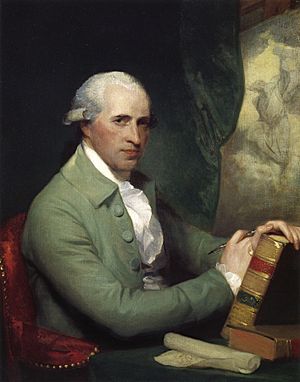
In August 1763, West arrived in England. He planned to visit before returning to America. But he never went back to America. He stayed in England for the rest of his life. In London, he met famous artists like Richard Wilson and Joshua Reynolds. He moved into a house in Covent Garden. His first painting in England was Angelica and Medora. He also showed a portrait of General Robert Monckton.
In 1765, he married Elizabeth Shewell. She was an American woman he had met in Philadelphia.
Important people like Dr Markham introduced West to other famous figures. These included Samuel Johnson and Edmund Burke. Several bishops also asked him to paint for them. In 1766, West suggested painting the inside of St Paul's Cathedral. This idea was not accepted. But his idea to paint an altarpiece for St Stephen Walbrook was approved. Around this time, he also became known for his classical paintings. These included Orestes and Pylades.
West became known in England as the "American Raphael." This meant people thought he was as good as the famous Italian painter Raphael. He believed that "Art is the representation of human beauty."
Working for the King
An archbishop named Drummond tried to help West. He wanted to raise money so West could focus on bigger paintings. When that didn't work, he convinced King George III to support West. West and the King became good friends. They often talked about art in England. They also discussed starting a Royal Academy of Art.
The Royal Academy began in 1768. West was one of the main leaders who helped create it. Joshua Reynolds became its first president. In 1772, King George made West the official historical painter for the court. He was paid £1,000 a year. He painted a series of eight large pictures for Windsor Castle. These showed scenes from the life of King Edward III. He also painted nine portraits of the royal family. This included two of the King himself. He was also in charge of the King's pictures until he died.
The Death of General Wolfe
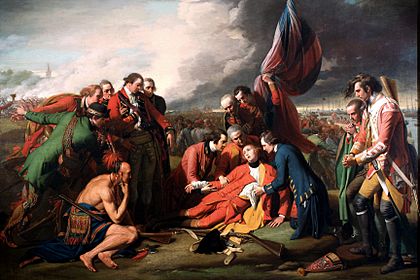
West painted his most famous work, The Death of General Wolfe, in 1770. It was shown at the Royal Academy in 1771. This painting became one of the most copied pictures of that time. It showed a scene from the French and Indian War. When the American Revolution started in 1776, West did not take a strong side. He did not speak for or against the war in his home country.
West became known for his large "history paintings." These paintings used strong figures, colors, and designs. They helped viewers feel like they were part of the scene. West called this "epic representation." His 1778 painting The Battle of the Boyne showed William of Orange's victory in 1690. This painting greatly influenced how William was shown in later art. In 1806, West painted The Death of Nelson. This painting honored Horatio Nelson's death at the Battle of Trafalgar.
Later Religious Paintings
St Paul's Church in Birmingham has an important stained glass window. It was made in 1791. It was based on a painting by West from around 1786. The window shows the Conversion of Paul.
West is also famous for his huge painting in the Chapel of St Peter and St Paul. This chapel is part of the Old Royal Naval College in Greenwich, London. His painting, The Preservation of St Paul after a Shipwreck at Malta, is very large. It shows a story from the Bible. West also designed other paintings in the chapel.
After losing some royal support in the early 1800s, West started painting many large religious works. The first was Christ Healing the Sick. He originally wanted to give it to a hospital in Philadelphia. But he sold it for £3,000. The British Institution then gave it to the National Gallery. West then made a copy to send to Philadelphia. This painting was very successful. It led him to paint even larger works. One of these was Death on the Pale Horse, shown in 1817.
Royal Academy Leadership
At first, some artists at the Royal Academy did not like West. They felt he was too ambitious. But when Sir Joshua Reynolds died in 1792, West was chosen as the President of the Royal Academy. He stepped down in 1805. But he was elected president again the next year. He served as president until he died.
West's Students
Many American artists came to London to study with Benjamin West. Some of his famous students included Samuel Morse, Robert Fulton, Charles Willson Peale, Gilbert Stuart, and John Trumbull.
Death
Benjamin West died at his home in London on March 11, 1820. He was buried in St Paul's Cathedral. He had been offered a special honor by the British King. But he turned it down. He believed he should be made a peer, which is an even higher honor.
Gallery
-
Pylades and Orestes Brought as Victims before Iphigenia, 1766
-
The Battle of La Hogue, c. 1778, National Gallery of Art
-
Treaty of Paris shows the American team at the 1783 Treaty of Paris. The British team would not pose, so the painting was never finished, c. 1783-84.
-
Welsh moral philosopher Richard Price, 1784
-
King Lear, 1788
-
The signing of the Treaty of Allahabad, 1765, between the British Governor of Bengal Robert Clive and Mughal Emperor Shah Alam, 1818, British Museum
Works
- John Sedley, view
- Portrait of a Gentleman, view
- Presentation of the Queen of Sheba at the Court of King Solomon, view
- The Envoys Returning from the Promised Land, view
See also
 In Spanish: Benjamin West para niños
In Spanish: Benjamin West para niños


